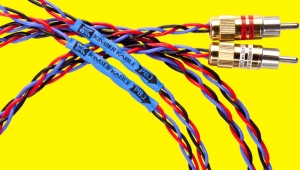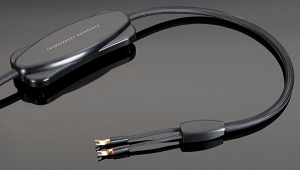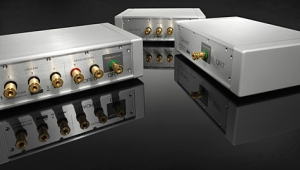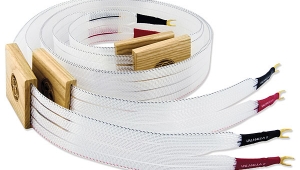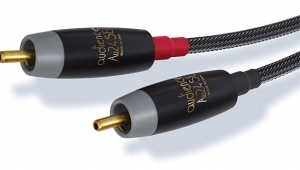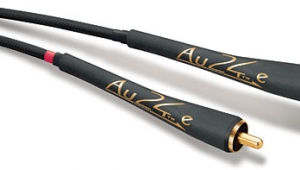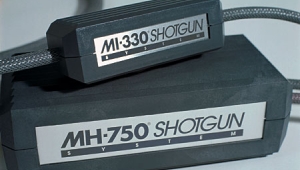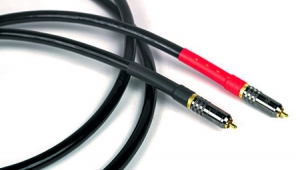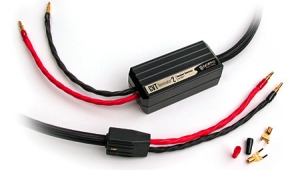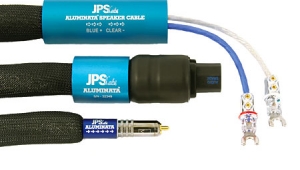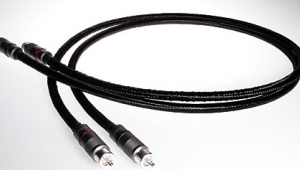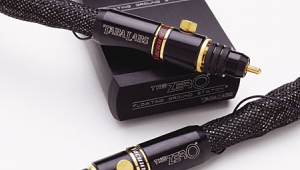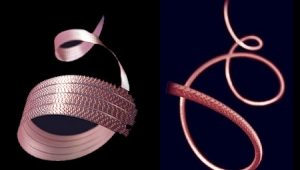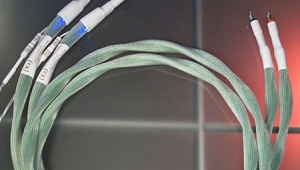| Columns Retired Columns & Blogs |
TARA Labs The Zero interconnect Page 2
A web of polyethylene filaments woven in a "large-windowed" braid is wrapped around the Teflon tube and acts as a spacer to separate the conductors from a shield of braided copper wire. Unlike in most other interconnects, the Zero's shield is allowed to "float." That is, neither end of the shield is attached to ground. Instead, both ends of the shield terminate in thin wires, to which are attached tiny pins (see later).
Footnote 1: Following publication of the review, we received a number of emails from readers who correctly pointed out that the air pressure at 12,000' altitude is nowhere near a vacuum. This subject was also discussed on the magazine's Web forum, with contributions from Matthew Bond as well as from readers.—Ed.
Fitted to either end of the Zero and soldered in place are complex RCA plugs, machined to mil-spec tolerances and fitted with O-rings and a clamping mechanism capable of providing a reliable air seal and thus of holding a vacuum. Each plug has a tiny valve, made with a spring and stainless steel ball with a Teflon seat. When assembly of the Zero is complete, the air inside it is evacuated to a pressure equivalent to an altitude of more than 12,000' (footnote 1), where there is insufficient oxygen for oxidation to occur and the uninsulated bare copper is thus protected from corrosion. The result, in short, is an interconnect of two parallel runs of bare copper wire (three for balanced) kept a constant 3/8" apart.
Why go to all this trouble to use a near-vacuum as a major part of the dielectric instead of fiber or plastic fillers such as cotton or rope, or the more traditional polyethylene or Teflon? Because all organic and plastic dielectrics are reactive. They absorb and release energy differently at different frequencies, which is one reason different dielectrics sound different when used in cables. A vacuum, on the other hand, is nonreactive; it does not absorb and release energy differently at different frequencies—which makes it the perfect dielectric.
Usually, wires are insulated by drawing the conductor through a die along with the heated, molten dielectric or insulation material. However, TARA claims that the extrusion of high temperature plastic materials can cause overheating and oxidation of the conductor surfaces, and that smooth clean wire surfaces sound more neutral and revealing. Its 99.999999% pure ("eight-nines pure") rectangular-solid core copper is "super-soft annealed," then polished.
Usually, too, you'd use twisted-pair construction to create common-mode rejection, which rolls off and reduces in-phase audio band noise along with RF energy above 20kHz–30kHz. However, this increases capacitance between the conductors to a minimum of 20–30pF/foot, even in the best interconnects. For the Zero, TARA claims a conductor-to-conductor capacitance of 3.4pF/foot, which means you can run lengths many times that of normal interconnect with significantly less high-frequency rolloff, and with bandwidth extending into the hundreds of thousands of hertz.
Of course, 100kHz and above is well beyond the frequency range of musical fundamentals and the limits of human hearing—but not of musical harmonics. For the Zero, Matthew Bond claims zero overshoot on squarewaves of 200kHz and well above, which he says is important for the proper reproduction of far lower frequencies. (I report. You decide (footnote 2). Bond also claims that because there is an electromagnetic field through and around any conductor, the dielectric used in traditional interconnects can actually delay the velocity of the propagation of the delicate HF range of the musical waveform, causing higher-order harmonics to be out of phase with the rest of the signal. (Again, I'm not equipped to confirm or refute any of this, so Fox Rules apply here as well.)
Because the Zero's shield "floats" completely, it must be grounded somehow. TARA includes a heavy little box, the Floating Ground Station, with every pair of Zeros. The box contains modules made of Ceralex, a combination of ceramic materials and metallic compounds that absorbs RFI and EMI. The black paint on the box is a special anti-absorptive/reflective coating that is said to keep out RFI and EMI.
The pins at the Zero's source end plug into this box. The pins at the other end (one M one F) plug into each other. The box is then grounded to any component that has a ground lug (such as a phono preamp), or to earth or a cold-water pipe. This establishes the ideal "star ground" configuration, with all interconnects grounded to the same single point. No voodoo here.
If you're thinking that the Zero's stiff Teflon tubing would make it impossible to dress the cable, it didn't. The area of the Zero where you'd normally bend an interconnect has accordion-like pleating that makes flexing it easy. It would be difficult to break the wire, Bond contends, because the super-annealing sufficiently softens it.
All of the above—and much more that would take up too much space—is what produced, contends Matthew Bond, the astonishing sound (or lack thereof) that I heard simply by inserting one pair of 1m Zeros into my system.
Back on the ground
And now let's gently touch ground: A 1m pair of Zero interconnects will set you back $14,900. I am sorry.
Here's the good news: A 2m pair of Zeros also costs $14,900. So does a 3m pair. The length required to go from my preamp to my amps costs a not-so-cool $17,000.
Why so expensive? Matthew Bond claims that each mil-spec RCA plug costs him $473.50. Times four equals $1894. That's his cost just for the plugs for a pair of Zero cables. With the average high-end audio retail markup being fivefold, you're talking close to $10,000 just for the plugs. On learning the plugs' cost, and after inspecting a nonworking sample Bond had left with me, some friends with manufacturing experience outside of audio said they were impressed by the design and construction, but that perhaps someone other than Bond should be in charge of parts procurement.
When I mentioned this to Bond, he laughed. "In the small quantities I order from this mil-spec machine shop, which supplies parts for projects so secret they don't actually know what they're building, that's the best I can do." Funnily enough, the actual wire is probably among the Zero's least expensive components—though nonetheless of extreme importance, Bond insists.
The whole enchilada
After hearing what a single set of Zeros could do, I told mbl's Jeremy Bryan to call TARA's Matthew Bond and tell him Please return, all is forgiven, and could I please hear my entire system wired with Zeros. Bond agreed, the dynamic duo returned, and digital and analog Zeros were installed throughout the system. (Bryan and Bond also soldered together a system-wide star ground, and installed TARA's nonvacuum but equally interestingly constructed Omega speaker cable, which costs $15,000 per 8' pair. I don't have room to cover it here, but the description of the overall system certainly includes their contribution.) Still, I feared that a little of a good thing that proved so spectacular might turn into too much of a good thing when used throughout the system.
My fears were unfounded. Wired up with these ridiculously expensive interconnects, my system reached even more exalted levels of musicality, detail, purity, harmonic expansiveness, attack, sustain, decay, realism, and everything else I've already described. The increase in backdrop quiet was enormous. When Jeremy Bryan removed the ground pin from the Floating Ground Station terminating the long run of Zero from preamp to amp, I could hear noise rush into the speakers. He reinserted the pin and the noise abruptly ended.
What's more, the Zero connecting the Manley Steelhead's variable output to the Alesis Masterlink's input has helped me produce some CD-R compilations that are nothing short of astonishing. Yes, it doesn't hurt to have the Continuum Audio Labs Caliburn turntable as a source, but I'd made pre-Zero compilations with other 'tables, and the difference was easily audible. If I could just shoot you a copy of the latest one, you'd know what I'm talking about.
Here's an example. I transferred the Grateful Dead's "Uncle John's Band" from a plain old original Warner Bros. LP I've played hundreds of times, including recently and pre-Zero. With the single Zero in place, the wood block, ridged gourd, acoustic guitars, and voices just plain sounded real—or at least closer to reality than I'd ever heard them before. The transient attacks were perfect—not hard and edgy, not soft and squooshy, just perfect. The Zero produced greater transparency and revealed more musical complexity than any other interconnect I've ever heard in my system, yet it was not at all bright. It was also smoother, warmer, and richer than any other interconnect I've heard, without sounding soft, rolled-off, or cloying.
There was one downside: Because of the Zero's ultrawide bandwidth, some outside transient noise does get into the system when nearby appliances are activated. I suspect the Zero may be problematic in New York City apartments or other impulse-polluted environments. When I mentioned this to Bond, he told me there are some fixes available that have worked perfectly. Evidently there are people who, believe it or not, can actually afford this interconnect, and who, on hearing their systems wired with it, buy it without hesitation or later regret.
Conclusion
Don't hate the messenger. A length of TARA Labs The Zero arrived in my listening room unannounced and unheralded, and I had no idea what it cost. But when it was inserted in my system, I knew immediately what it was doing to the sound. And when the entire system was wired with Zeros, it sounded even better.
Is the Zero's astonishing performance the result of its low-pressure dielectric? The lack of insulation or dielectric material around the conductor? The in-phase propagation of frequencies only a bat can detect? The parallel construction, which yields ultrawide bandwidth and ultralow capacitance? The floating-shield/star-ground arrangement, which avoids terminating RFI/EMI contamination into the RCA plug's ground and thus directly into the associated equipment? All of that? Some of that? Other reasons yet unknown?
I don't know. All I know is that everyone familiar with my system who's come down here for a listen during the many months the Zeros have been here has easily been able to hear their purifying effect on the music. My wife, though a good listener, hardly qualifies as an audiophile, and she nailed it in a minute.
The Zeros didn't change the flavor of my system. They produced a new sensation unique in my listening experience. I've now had them long enough to know that my ears aren't being fooled by rolled-off highs or softened transients, because there's nothing mellow or soft about the sound. It's just fundamentally, musically right.
There are plenty of audiophiles out there who have what's technically referred to as "F---you money." They can afford to blow $40,000 or $50,000 on cables for their audio systems. I don't think there's a one of them who would hear the TARA Labs Zero and not buy it without hesitation. I wonder if anyone's had them installed and then rejected them. I doubt it.
The rest of us can dream—and hope that TARA Labs, or someone else, finds a way to produce this technology at a reasonable cost.
Footnote 1: Following publication of the review, we received a number of emails from readers who correctly pointed out that the air pressure at 12,000' altitude is nowhere near a vacuum. This subject was also discussed on the magazine's Web forum, with contributions from Matthew Bond as well as from readers.—Ed.
Footnote 2: For an interesting discussion of the importance of ultrasonic frequencies in music, read Cal-Tech Professor James Boyk's essay.
- Log in or register to post comments
